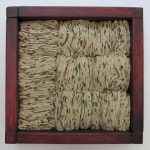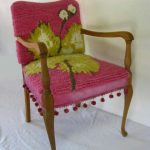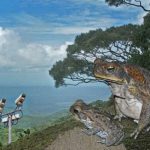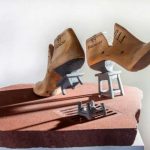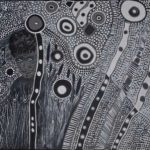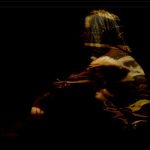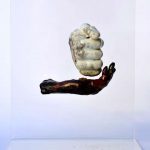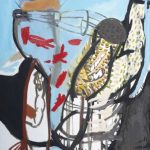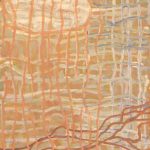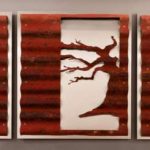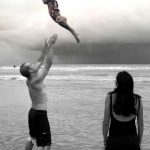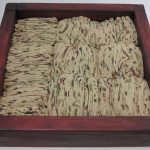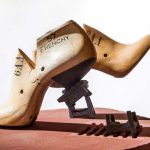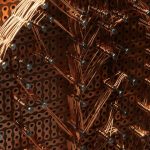2013 QRAA Award Winners
- The Wayne Kratzmann Award – Renton Bishopric, Coal for Breakfast
- Young Artist Development Award – Jasmine Jean, That Place inside Me
- TAFTA Textile Prize – Ali George, My Father’s Shed
- The Edge Digital Award – Christine Turner, Immersed
- Art Shed Brisbane People’s Choice Award – Seabastian Toast, Pig Posy
Touring Exhibition
Click the images below to view larger pictures of these artworks.
Artist: Mary Elizabeth Barron
Artist Location: Ormeau
Medium: Clear plastic fruit & vegetable bags, synthetic fibre thread, polyester thread (2013)
Artist Statement:
As a Gold Coast resident the sea plays a big part in my life and that of the local economy including tourism, beach culture and the seafood industries. The volume of plastic waste in the water extensively contributes to the deteriorating health of our oceans. According to biologist Miriam Goldstein, “If trends continue, we’re going to see more plastic than fish”. This statement brings home the urgency to take action to reduce, reuse and recycle. I seek to draw attention to this by the use of plastic bags to make this work. The white references the coral bleaching that is occurring due to climate change. The starkness and beauty of these tightly woven and intricate forms aims to imbue an ethereal quality and serve as an eerie reminder to be mindful of how we consume, use and dispose of our plastics and of the realities facing sea life.
Artist: Ali George
Artist Location: Tarome
Medium: Cotton (hand dyed, rusted), batting, thread (2013)
Artist Statement:
I am a textile and mixed media artist living on the edge of the Scenic Rim (Tarome). I have been a quilter since 1987. Through the language of textiles and thread I create art quilts and textile works that explore the nature of relationships and change. I create fabric pieces, building change through layers of texture using dyes, rubbing with oil based pigments, overprinting with textile paints and machine stitching. My Father’s Shed explores feelings of grief, loss and the experience of monumental change when moving after forty years of him working in his sacred space and place. Creating the quilt required acceptance of change – the process of printing tools, tins, nails – his lifetime of collecting those things that might one day be useful, abruptly discarded in the metamorphosis. My Father’s Shed is layered and stitched with the memory of living change.
Artist: Andy Powell
Artist Location: Noosa Heads
Medium: Silver Gelatin Print (2012)
Artist Statement:
The S.S. Dicky was forced onto the beach during heavy seas in 1893 and today only the skeleton of the ship’s hull remains. The S.S. Dicky quickly became a local attraction and has remained partially on the beach since the wrecking of the vessel. Local reports say that due to changes of the wreck, it is now unsafe and may be removed completely in the near future. The photograph was taken after sunset with a 35mm film camera. A long exposure was needed to light the scene with the available moonlight, causing the crashing waves to blur into a smooth mist around the remains of the shipwreck. The silver print was made in the darkroom using traditional wet printing techniques.
Artist: Barbara Pierce
Artist Location: Townsville
Medium: Mixed – Recycled house timeber, curtains, thread, acrylic paint (2013)
Artist Statement:
This work reflects upon changes occurring in residential house and land developments both locally and as a widespread phenomenon. In post-war Australia a quarter-acre block was the term used for an average suburban house block. Land prices, population growth, a changing economy and environmental sustainability concerns have altered the concept of the quarter-acre block as being considered average, affordable or desirable. A trend towards high-density living in smaller spaces is now considered more economically and environmentally viable. The interior of this work is made from cut, folded and stitched curtain lengths which when joined end to end measure the perimeter of a quarter-acre block.The timber frame contains these measured lengths in a tightly packed manner evocative of a high-density living space. Recycled materials and a low tech working method were use in the creation of this work.
Artist: Bec Andersen
Artist Location: North Tamborine
Medium: Found chair, reupholstered hand made fabrics. The seat is hand tufted fabric, 100% wool. Back/sides are hand-dyed pongee silk, and knitted braid and pom poms are hand-spun silk. Dyes used: osage (2013)
Artist Statement:
Living change, changing lives , lives altered , and devastated. After the sheer devastation of a bushfire, comes new life. Wattle is usually the first flower to appear after a bushfire. It is resurrected from the dead, as is this old chair, restored and ready to live again. It is my representation of living change. I believe we need to burn off the ideals of the industrial revolution, and all that mass production brings with it. We need to rediscover the value of objects made by hand with integrity and skill. I am calling for the resurrection of the traditional craftsmanship of the past: rug making, knitting, lace making, tapestry, weaving, needlework, sewing and even upholstery. I work with my hands to restore and renew.
Artist: Buck Richardson
Artist Location: Kuranda
Medium: Photograpy/Digital Art – digital print mounted on acrylic (2013)
Artist Statement:
More and more you can be sure of two things in rural and remote Queensland. We may have left George Orwell’s 1984 way behind but the spread of Big Brother is inexorable, living change incarnate. CCTV cameras are sprouting like weeds in the most unexpected places. And the march of Bufo marinus seems unstoppable. In my depiction of Big Brother on the peak of Mt Lewis in Far North Queensland, ambiguity is central. Who is watching whom? Is anybody taking notice? Does anyone care?
Artist: Chee Fong Hew
Artist Location: Peachester
Medium: Timber, carved granite heels, sandstone (2012)
Artist Statement:
This work speaks of an underlying discontent and a sense of helplessness within our society; the fabric of which is changing and sometimes not always for the better. The current economic environment and changing social attitudes mean that most families need duel incomes in order to make ends meet. More women are in the workforce now than there has ever been—according to the Queensland Department of Statistics. Many women find themselves in the unenviable role of having to balance the relentless responsibilities of family, home, relationships and work. My passion as a sculptor is working with stone—from monumentally scaled works destined for public spaces to delicately carved works small enough to be held in one hand. The medium is versatile and expressive, both strong and able to convey fragility, connecting its audience to the earth itself.
Artist: Cheryl Moggs
Artist Location: Wilsonton
Medium: Acrylics on canvas (2013)
Artist Statement:
As a self taught artist my visual journey begun on my homeland creating symbols and storylines upon the black soil with my digging stick. Today I create and document those symbols and storylines on a different surface with a paintbrush and acrylics. Creating marks to preserve and transmit traditional knowledge in a contemporary environment. To coexist in two worlds. Change is evident, cultures exist and continue to fight to exist, history prevails; Mother Earth and traditions responds to destructive man made progressions like scars upon our spirituality, identity and country. Who am I then If I don’t have culture, Just a reflection on Mother earth, to become empty as Mother Earth closes her eyes to sleep one more. Awakening to emptiness without spirit or Place!
Artist: Christine Turner
Artist Location: Bundaberg
Medium: Digital (2013)
Artist Statement:
The recent floods in Bundaberg resulted in a community in deep shock. We had never contemplated the possibility of a disastrous event of this scale happening. We had been complacent, and paid a high price. Our lives were changed forever. My work depicts the figure in the ‘floodscape’. It is a merging of a photograph of a woman with an aerial photograph of the landscape around Bundaberg. ‘Immersed’ represents the deep psychological impact the floods had on the people of Bundaberg.
Artist: Glenda Stasse
Artist Location: Cooran
Medium: Ceramic on perspex stand (2012)
Artist Statement:
I am a ceramic artist with an interest in politics who prefers to use recycled clay and low energy Raku firing techniques. This enables me to conserve valuable resources and have a lighter footprint on the Earth which is intrinsic to my philosophy. My Perspex and Raku fired ceramic sculpture “Vincent and Gough” is a depiction of the historic moment in 1975 when Prime Minister Gough Whitlam poured the soil of the Northern Territory into the hand of Vincent Lingiari who represented the Guringi people. The importance of the Aboriginal land rights movement and the significance of the ceremonial pouring of the soil is worth highlighting. This respectful gesture signalled a pivotal moment and the start of a living change for all Australians but especially for Indigenous Australians who are now increasingly taking leadership roles in politics, education and the arts. This living change benefits all Australians.
Artist: Gary Abkin
Artist Location: Eastern Heights
Medium: Oil on Canvas (2013)
Artist Statement:
‘Living Change’ is expressed and can be witnessed in the moment. The path or lines, delivery, the layers, symbols and the sight of boat people, the asylum seeker as a familiar undefined and abstract moment for the watcher. These works are informed by the sea and it’s given tragedy or opening, whether as a propellant or end. The ‘Living Change’ is unstill and travels with the weight of stories carried within the people making this journey and the repressed insights and compassion of the silent witnesses.
Artist: Fran Robinson
Artist Location: Scarborough
Medium: Hand Embroidery on Canvas (2013)
Artist Statement:
Australia can be a land of extremes, particularly regarding rainfall or the lack of it. We watch Nature give with one hand while taking with the other. Heavy rains during the last few summers brought an end to the long drought of previous years when dams, lakes and rivers ran dry. Yet those same rains brought devasting floods to much of our country. We watched in horror as people, animals and buildings were swept away. Precious crops and topsoil disappreared. Beaches were savegely eroded and littered with debris as the muddy tides wreaked havoc along out shores. The fortitude shown by the people of our communities in the face of such extremes is the inspiration behind this picture.
Artist: Felicia Lloyd
Artist Location: Gladstone
Medium: Digital Prints (2013)
Artist Statement:
There is a clear division between old town and new town. Locals Vs FIFO’s (fly in fly out workers). Anyone who was born here is a local everyone else is a hazard. They call it boomtown. We call it a bust. In Gladstone everyone who can works hard and plays hard. Show ponies come out on race days. Drunk girls in fascinators carrying their shoes piss in the main street at midnight. Hot cars, boob jobs and tattoos. What else is there to do. I keep hearing the statement – “Living the dream”. I’m not sure if I’ll wake.
Artist: Ellie Morley
Artist Location: Gold Coast
Medium: Cross Stitch on men’s business apparel (2012)
Artist Statement:
Although today the human mind is shaped by the modern social world, it has been adapted to the natural environment in which it evolved. This work reflects the change that has occurred in my lifetime of people reverting to their country roots- a tree change if you like. People are increasingly balancing a busy working life existence with a rural retreat. The country is a necessary part of our soul and Ecopsychology explores the connection between ecology and human psychology. When we distance ourselves from our country connections it has negative effects on our psyche, developing a close connection and empathy for our rural and remote environment can only help us to nurture and protect our natural heritage – whilst enhancing the marriage between the yin and yang of our culture, the urban and the rural.
Artist: Helen Dennis
Artist Location: Chinchilla
Medium: Acrylic (2013)
Artist Statement:
Part of my identity has been of a rural woman accepting of my ‘isolation’ and strongly connected to my local community. The events of the last few years, as emphasised by council amalgamation and the rise of the mining industry, leaves a permanent and deep rendering of my community’s cohesiveness. The loss of our local council, the impact of a rapid population increase, and the physical intrusion upon our farmlands, has caused massive faultlines within our community ethos. Subsequently it is increasingly difficult to identify with an ethos that seeks a pathway influenced by regional, state and national agendas, denying local needs. As a symbol of my discontent I have chosen one of the more obvious symbols of the change process – the fluoro workshirt – the shirt hovers above the ‘faultlines’ and their impacts. Its ubiquitous nature encompasses the unilateral changes that have reduced unique communities to homogeneous ‘hodgepodges’.
Artist: Jasmine Jean
Artist Location: Condon
Medium: Ink, enamel, charcoal, oil (2013)
Artist Statement:
As a person living with mental illness, I having recently recovered from a mental breakdown. For this point in my life, I had related to the notion of ‘’living change’’ in a uniquely personal way. It meant personal growth, liberation and adaptation in difficult circumstances. Using an expression of the subconscious I have attempted to reproduce, in my experience, how the peculiarity of mental illness feels. Communicating emotional chaos through accident and chance, I have considered the instinctive creative process of most importance, with little concern for representation or rationality in subject matter. It is a liberating process to connect with my inner chaos, to introspect and to self-observe, as it opens the possibility for personal growth, self-awareness and artistic freedom.
Artist: Jennifer Wright Summers
Artist Location: Toowoomba
Medium: Kauri branches, tea bags and acorn tops coated with shellac. Pen on teabags. Chain. (2012)
Artist Statement:
The history of Australia has been told by the winners and it’s time we recognised that. Using an assemblage of native and European plants, this piece “The Impact of Colonisation” demonstrates settlers’ attitudes to the first people. They were seen as ‘savages’, vermin and less than human. Settlers sought to remove the first people, take over their land, hide their guilty secret and cover this ancient civilisation with what they saw as more ‘cultured’ and ‘modest’ influences. Agathis robusta (South East Queensland’s native conifer) branches coated in layers of shellac, represent the first peoples. The branches are attached to tea bags strengthened with shellac and attached to an acorn cap representing the colonisers. Viewers are encouraged to touch the work and read the stories. The chain represents how the first people were chained, rounded up, incarcerated in an attempted genocide.
Artist: Kerry Blackwell
Artist Location: Tewantin
Medium: Acrylic on Stonehenge (2013)
Artist Statement:
I use visual imagery as a vehicle for self discovery and expression to gain greater perception of myself and the world in which I live. As an artist, I have explored the Australian landscape through drawing, mixed media, painting and sculpture. My studio practice is a process, an openness in which I am co-dependent with the materials and form, responding to every previous response until a distilled presence is liberated and revealed to me. In exploring the landscape I am interpreting the natural process of change and what may reside beyond and within its forms.
Artist: Kerry Williams
Artist Location: West Mackay
Medium: Mixed media – fabric and acrylic paint on paper base (2013)
Artist Statement:
For some time now I have been curious about certain transformations in our society. “Single Occupant Dwellings” is my response to statistics I had read regarding the growth in the number of women now living alone in Queensland and is a contemporary example of living change. Whether it is by choice or circumstance this is a way of life for a growing number of women in our state. In my work I am often drawn to red and black – as used in this piece. I use the frayed fabric (cut into specific shapes) to represent people and finish the image with acrylic paint for lines and layers of paper. The paper is important because I use the contrast in the different textures and the tears to create lines. My desire is to reduce the image to only as many shapes and lines as is needed to convey meaning.
Artist: Kim Schoenberger
Artist Location: Buderim
Medium: Assemblage; Stainless Steel and Corrogated Iron – Triptych (2013)
Artist Statement:
Kim continues to ride her art like a teeter board, a continuous wrestle with balance, texture versus form, line versus tone, negative versus positive. In “Resilient” we have the sensual sleekness of the stainless steel finding its place against rusty iron, the fragile lines contrasting with the bold gestures of the corrugated steel and the empty spaces perfectly balancing the filled. And in this emerges a story, a narrative of survival, one final balancing act where Kim asks us will mankind overwhelm nature or will a tree’s ability to change with its environment leave it to bare witness over man’s demise.
Artist: Louisa Ennis-Thomas
Artist Location: Cairns
Medium: Perforated aluminium, mirror, mixed media (2012)
Artist Statement:
Exploring intersections between the natural and the artifice, “Hanging gardens: reflections” examines transitory interactions between constructed and natural environments and considers our endless desire to control and manipulate the physical world around us. Evidence gathers regarding the human impact on the environment as we reflect upon our role as global stewards and move towards accepting responsiblity for ‘living change’ in all its guises.
Artist: Mary Elizabeth Barron
Artist Location: Ormeau
Medium: Clear plastic fruit & vegetable bags, synthetic fibre thread, polyester thread (2013)
Artist Statement:
As a Gold Coast resident the sea plays a big part in my life and that of the local economy including tourism, beach culture and the seafood industries. The volume of plastic waste in the water extensively contributes to the deteriorating health of our oceans. According to biologist Miriam Goldstein, “If trends continue, we’re going to see more plastic than fish”. This statement brings home the urgency to take action to reduce, reuse and recycle. I seek to draw attention to this by the use of plastic bags to make this work. The white references the coral bleaching that is occurring due to climate change. The starkness and beauty of these tightly woven and intricate forms aims to imbue an ethereal quality and serve as an eerie reminder to be mindful of how we consume, use and dispose of our plastics and of the realities facing sea life.
Artist: Jason Nelson
Artist Location: Clear Island Waters
Medium: Interactive Digital Artwork (2013)
Artist Statement:
Surrounded by boxes of dangerous creatures is an interactive artwork, an infinitely zooming/clicking mosaic comprised of 170 text/image tiles, which combine and recombine as you click and move and click. The recombinatory nature of the artwork embodies the idea of Living Change, how small worlds are hidden within the larger and ever changing mosaic of our landscapes The images come from Newcastle and the Gold Coast, cities just close enough to major centres to feel their magnets and filter their unwanted, stuck between desire and geography, struggling to find some future beyond industry and tourism. In essence cities of continual change. Each tile of this addictively clickable digital artwork is a small ficto-history and signs of the difference between. As each new mosaic is formed, we must search for what we haven’t seen, finding connections to what continually re-arrives.
Artist: Wendy McGrath
Artist Location: Cooroy
Medium: Photography (2013)
Artist Statement:
The photograph comes from my direct experience with the changing cultural landscape of regional Australia. Born as a fifth generation Australian, my children have expanded the cultural horizons of our family by marrying partners from Indigenous backgrounds. Within our three living generations the very separate cultures of Indigenous Australians and descendants of the colonial settlers, have now merged to become the family of the new Australia. The photo was taken at Noosa Main Beach, the home country of my son, where he was born, went to school, and now returns with his wife and daughter. It was an afternoon of remarkable storms, which provided unique lighting for the shot and a dramatic setting for the story to be told.
Artist: Veronika Zeil
Artist Location: Rockyview
Medium: Coffee, charcoal and binder on paper (2012)
Artist Statement:
The main themes of my art works are based on the idea that landscape is a cultural construct inspiring a pictorial representation of spaces created by geological, organic and manmade transformations. The works explore transitions in the landscape caused by geological and organic processes as well as the transitions directed by humans. Flattening and fracturing space, minimizing the pictorial elements such as colour, line and objects to evoke the material reality of landscape elements in a map-like representation allow me to explore some of these concepts. “Mapping Progressive Development” interprets the theme of the continuously evolving state of landscape systems environment through applying the Fibonacci number sequence. The Fibonacci numbering sequence relates to natural systems as well as the progressively larger developments of the landscape. The drawings below were done on the basis of the Fibonacci Series on progressively larger sheets of paper in sets of seven.
Artist: Seabastion Toast
Artist Location: Palm Beach
Medium: Acrylic on Canvas (2013)
Artist Statement:
This work is part of a larger exploration into the relationship humans have with animals and subsequently, their environment. I am interested in both our physical reliance on the animals as well as our metaphoric constructions surrounding archetypes and mythology. The painting “Pig Posy” is a response to both the appalling conditions sows are kept in most factory farms and, conversely, our very intimate use of pigs to grow human organs for transplant. I find the hybridisation of the human/animal dichotomy particularly interesting as this challenges notions of an animal kingdom heirarchy. I find the implied hybridisation of species and subsequent evolutionary consequences a fascinating area of both philosophy and medical research and is very aptly surmised in the theme of living change.
Artist: Robbyn Gergos
Artist Location: Maryborough
Medium: Oil (2012)
Artist Statement:
Country Cordalba born and raised, “Ando” was deployed to Afghanistan in 2011 for 10 months of perilous service. With a close personal connection, my son- in- law “Ando” has been portrayed as I imagined him carrying out typical daily duties within the Chinooks. Leading a double life of serving his country, Ando then returns home to his previous way of life as a caring husband, father, son, mate and co-worker. It’s my intention to highlight the need of rural communities to support these families with loved ones in the military. Be with the families as they learn to adapt to dual roles and experience their own sacrifices and hardships. As a community, welcome and support these heroic soldiers as they encounter the difficult transition back to civilian life, after all these soldiers have contributed to making a better life for you and your decedents.
Artist: Renton Bishopric
Artist Location: Byfield
Medium: Ceramics (2013)
Artist Statement:
“Coal for Breakfast?” speaks of my local environmental concerns, specifically the impact of coal mining and the industrialisation of the Great Barrier Reef. I see first-hand the impacts of the coal industry around our coastline and inland. The polluted estuaries, devastated ecosystems, sick animals, complaints of unclean air and foul drinking water. The social and financial struggles of farming families and communities as mining companies ruthlessly take over agriculture. I am faced with the question; “What will we eat, drink and breathe…?” In my work “Coal For Breakfast?”, I’ve used destructive techniques to alter an otherwise perfect form, my literal participation in this bringing me even closer to the unpleasantness of my imagined future.
Artist: Rebecca Ross
Artist Location: Burleigh Heads
Medium: Map collage, map pins, foam board (2012)
Artist Statement:
My map collages are made up of continents,countries,states and territories that are collaged and pinned together to create new geographical entities.Each hand-cut piece of map meshes with another, splicing terrains and linking to form a survey of an area and a topographical profile.The artwork “Find Your Way” explores the theme of “Living Change” via the changing landscapes and shifting topographies of regional and remote areas,whether it be the changing coastline on the Gold Coast (where I live) due to erosion or the impact of mining, cyclones and population growth in other areas, the landscape is constantly shifting.This artwork navigates notions of the changing landscape and the idea of ‘Finding Your Way’ in the ever-moving, ever-shifting environment of ‘Living change’. I refer to my artworks as exercises in mapping; these exercises are concerned with mapping the junctures of site, situation and sensation and exploring elements of natural, man-made and human geography.
Artist: Noela Mills
Artist Location: Maleny
Medium: Recycled found silk flags (2013)
Artist Statement:
The theme of living change conjures up images of migration to Queensland, from early migrant settlement to present day backpackers and fruit pickers. All of these people – immigrants and itinerant workers alike have added to the rich cultural diversity that is today’s Queensland. Today’s young backpackers are here on a fun-filled adventures, but the early days saw incredible hardship in foreign lands. This apron/dress represents the women of the times, doing it tough in a hot, hostile and often remote region, isolated from family and friends back home. The fragile, disintegrating silk flags allude to mixed races coming together; ‘stitched together’ to create ‘a fabric for survival’ which was necessary but not always easy – thus “The Fragility of Multiculturism”.
Artist: Ali George
Artist Location: Tarome
Medium: Cotton (hand dyed, rusted), batting, thread (2013)
Artist Statement:
I am a textile and mixed media artist living on the edge of the Scenic Rim (Tarome). I have been a quilter since 1987. Through the language of textiles and thread I create art quilts and textile works that explore the nature of relationships and change. I create fabric pieces, building change through layers of texture using dyes, rubbing with oil based pigments, overprinting with textile paints and machine stitching. My Father’s Shed explores feelings of grief, loss and the experience of monumental change when moving after forty years of him working in his sacred space and place. Creating the quilt required acceptance of change – the process of printing tools, tins, nails – his lifetime of collecting those things that might one day be useful, abruptly discarded in the metamorphosis. My Father’s Shed is layered and stitched with the memory of living change.
Artist: Barbara Pierce
Artist Location: Townsville
Medium: Mixed – Recycled house timeber, curtains, thread, acrylic paint (2013)
Artist Statement:
This work reflects upon changes occurring in residential house and land developments both locally and as a widespread phenomenon. In post-war Australia a quarter-acre block was the term used for an average suburban house block. Land prices, population growth, a changing economy and environmental sustainability concerns have altered the concept of the quarter-acre block as being considered average, affordable or desirable. A trend towards high-density living in smaller spaces is now considered more economically and environmentally viable. The interior of this work is made from cut, folded and stitched curtain lengths which when joined end to end measure the perimeter of a quarter-acre block.The timber frame contains these measured lengths in a tightly packed manner evocative of a high-density living space. Recycled materials and a low tech working method were use in the creation of this work.
Artist: Chee Fong Hew
Artist Location: Peachester
Medium: Timber, carved granite heels, sandstone (2012)
Artist Statement:
This work speaks of an underlying discontent and a sense of helplessness within our society; the fabric of which is changing and sometimes not always for the better. The current economic environment and changing social attitudes mean that most families need duel incomes in order to make ends meet. More women are in the workforce now than there has ever been—according to the Queensland Department of Statistics. Many women find themselves in the unenviable role of having to balance the relentless responsibilities of family, home, relationships and work. My passion as a sculptor is working with stone—from monumentally scaled works destined for public spaces to delicately carved works small enough to be held in one hand. The medium is versatile and expressive, both strong and able to convey fragility, connecting its audience to the earth itself.
Artist: Donna Davis
Artist Location: Deebing Heights
Medium: Mixed media: copper wire, reclaimed timber, Perspex, nails, circuit-boards (2013)
Artist Statement:
Plants are the living life support system for our planet, however we are losing species at an alarming rate. Leaves of Change represents five endangered plants, depicting the intricate leaf structure of each species through coiling copper wire around nails embedded into circuit-boards; a technique used to reference energy production. With the ability to gather and create their own energy for survival, plants play a vital role for the health of our planet, and our daily lives; providing intrinsic resources such as water filtration, air quality, climate control, food production, medicinal needs and shelter. It is estimated, however, that one in every five plants are vulnerable to extinction, with human activities such as urbanisation, mining and logging threatening their survival. Portraying these endangered plants as living powerhouses, this work invites the viewer to consider the ecological implication of species loss: a ‘living change’ happening in our lifetime, in our communities.
Vincent and Gough 2
Artist: Glenda Stasse
Artist Location: Cooran
Medium: Ceramic on perspex stand (2012)
Artist Statement:
I am a ceramic artist with an interest in politics who prefers to use recycled clay and low energy Raku firing techniques. This enables me to conserve valuable resources and have a lighter footprint on the Earth which is intrinsic to my philosophy. My Perspex and Raku fired ceramic sculpture “Vincent and Gough” is a depiction of the historic moment in 1975 when Prime Minister Gough Whitlam poured the soil of the Northern Territory into the hand of Vincent Lingiari who represented the Guringi people. The importance of the Aboriginal land rights movement and the significance of the ceremonial pouring of the soil is worth highlighting. This respectful gesture signalled a pivotal moment and the start of a living change for all Australians but especially for Indigenous Australians who are now increasingly taking leadership roles in politics, education and the arts. This living change benefits all Australians.
Artist: Jennifer Wright Summers
Artist Location: Toowoomba
Medium: Kauri branches, tea bags and acorn tops coated with shellac. Pen on teabags. Chain. (2012)
Artist Statement:
The history of Australia has been told by the winners and it’s time we recognised that. Using an assemblage of native and European plants, this piece “The Impact of Colonisation” demonstrates settlers’ attitudes to the first people. They were seen as ‘savages’, vermin and less than human. Settlers sought to remove the first people, take over their land, hide their guilty secret and cover this ancient civilisation with what they saw as more ‘cultured’ and ‘modest’ influences. Agathis robusta (South East Queensland’s native conifer) branches coated in layers of shellac, represent the first peoples. The branches are attached to tea bags strengthened with shellac and attached to an acorn cap representing the colonisers. Viewers are encouraged to touch the work and read the stories. The chain represents how the first people were chained, rounded up, incarcerated in an attempted genocide.




